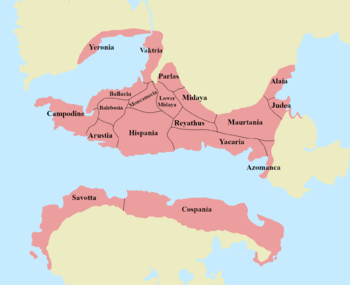Romanyan Empire
Jump to navigation
Jump to search
Romanyan Empire Imperium Romanum | |||||||||||||||||||||
|---|---|---|---|---|---|---|---|---|---|---|---|---|---|---|---|---|---|---|---|---|---|
| 35 BC – 482 AD (unified) 482 – 680 AD (Northern Romanyan Empire) 482 – 1350 AD (Savottan Empire) | |||||||||||||||||||||
 Map of the Romanyan Empire at its greatest extent, c. 150 AD | |||||||||||||||||||||
| Status | Historic country | ||||||||||||||||||||
| Capital | Romanya (35 BC - 680 AD), Savotta (680 - 1350) | ||||||||||||||||||||
| Common languages | Romanyan Iberic | ||||||||||||||||||||
| Religion | Romanyan Paganism, Romanyan Christianity | ||||||||||||||||||||
| Demonym(s) | Romanyan | ||||||||||||||||||||
| Government | Semi-elective, functionally absolute monarchy. | ||||||||||||||||||||
| Emperor | |||||||||||||||||||||
| Historical era | Ancient | ||||||||||||||||||||
• Empire Established | 35 BC | ||||||||||||||||||||
• Division of the Northern Romanyan Empire and the Savottan Empire | 482 AD | ||||||||||||||||||||
• Fall of Romanya | 680 AD | ||||||||||||||||||||
| 1350 AD | |||||||||||||||||||||
| Population | |||||||||||||||||||||
• 25 BC | 56,800,000 | ||||||||||||||||||||
| Currency | Sestertius, Denarius, Aureus, Solidus | ||||||||||||||||||||
| |||||||||||||||||||||
| Today part of | |||||||||||||||||||||
The Romanyan Empire (Romanyan Iberic: Imperium Romanum) was the post-Republican period of Ancient Romanya. As a polity, it was one of the largest nations ever in Terraconservan history which consisted of large territorial holdings in southern Ecros and northern Sur, mainly around the Alzanub Sea, which were ruled by emperors. During the Principate, established by the first emperor Augustus, from 35 BC until 264 AD, a single emperor ruled from the capital city of Romanya. The Dominate, established by emperor Diocletian, divided the empire and would last until the fall of the Northern Romanyan Empire in 680.
Contents
History
Transition from Republic to Empire
Romanyan Expansion
Tetrarchy
North and South split
Fall of Romanya and survival in the South
Geography and demography
Provinces
- Alaia 35 BC - 630 AD
- Tharsia 35 BC - 680 AD
- Azomanca 31 BC - 641 AD
- Balebosia 35 BC - 680 AD
- Ballacia 35 BC - 636 AD
- Campodine 35 BC - 680 AD
- Dastivia 325 - 515 AD
- Dacia 35 BC - 657 AD
- Judea 35 - 633 AD
- Midaya 35 BC - 655 AD
- Midaya Inferior 35 BC - 622 AD
- Moncamecia 35 BC - 629 AD
- Parlas 35 BC - 621 AD
- Savotta 35 BC - 680 AD (continued with the Savottan Empire)
- Urberonnia 15 - 306 AD
- Vaktria 130 - 325 AD
- Yacaria 35 BC - 655 AD
Client States
- Craeperia Citerior 110 BC - 193 AD

